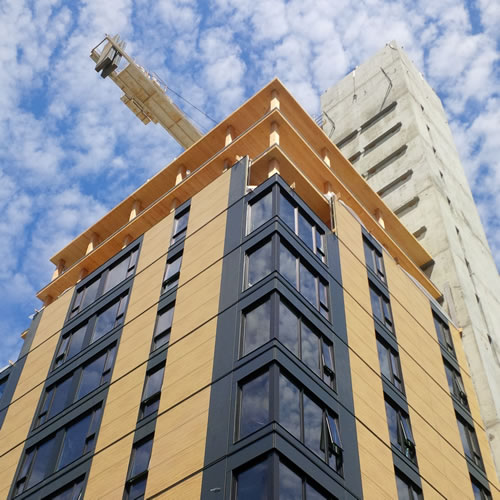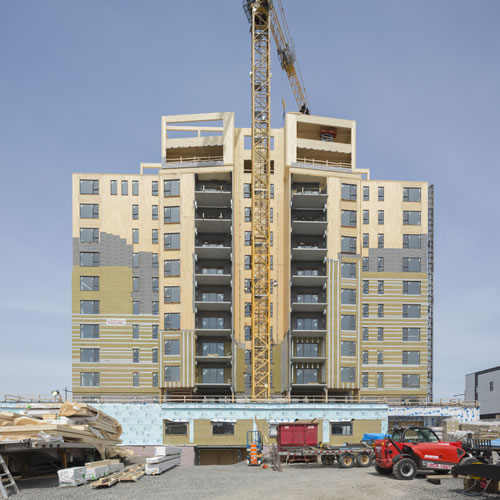
The popularity of building materials that come from renewable resources, such as wood, is increasing worldwide. Wood-based materials use less energy and emit fewer greenhouse gases (GHG) and pollutants over their life cycle than traditional, energy-intensive construction materials.
Consequently, using wood can help reduce the carbon footprint of most buildings and lower GHG emissions created by the built environment. In turn, building with wood can help Canada achieve its climate change goals and increase the competitiveness of its forest industry by fostering the demand for Canadian wood products.
Why build more with wood?

Photo: © Stéphane Groleau, courtesy of Cecobois
The ease of assembly, reduced noise and waste, and the natural beauty of wood coupled with its cost-effectiveness and environmentally friendly attributes make wood well suited for use in infrastructure projects and in bigger and taller buildings.
A variety of innovative wood-based products and structural solutions have been developed over the past few years and are now available for use in various segments of construction. In particular, pre-fabricated wood building components and a new generation of engineered wood products, such as panels and beams, offer strength properties and safety performance on par with more traditionally used construction materials.
Recognizing wood construction in our building codes
Market and scientific analyses indicate an interest in the construction industry for the use of wood in buildings taller than 10 storeys, referred to as tall wood buildings. However, broad public acceptance of wood as a construction material requires establishing wood-friendly policies, codes and standards.
To spur innovation and certify the performance of wood as a construction material, Natural Resources Canada (NRCan) has been funding the research and development of new generations of wood-based products, systems and structural solutions since 2007.
Another North American first
Experience gained through design testing and the construction of the Origine building was the foundation for a made-for-Quebec technical guide that offers approved design solutions for mass timber buildings up to 12 storeys. With the release of the Directives and Explanatory Guide for Mass Timber Buildings of up to 12 Storeys in August 2015, the Government of Quebec became the first jurisdiction in North America to officially support the construction of tall mass timber buildings.
These strategic investments, along with work with scientific experts and regulatory agencies, led to the adoption of wood frame construction up to six storeys in the 2015 edition of the National Building Code of Canada (NBC). Today, British Columbia, Quebec, Ontario, Alberta and Nova Scotia have amended their respective building codes to allow mid-rise wood frame construction.
As a result, over 500 mid-rise buildings across Canada are either completed, under construction or at the design and development stage.
Efforts to level the playing field for wood-based construction in Canadian codes and standards continue. In collaboration with the National Research Council, the Canadian Wood Council and FPInnovations, NRCan is supporting the development of code revisions targeting the 2020 edition of the NBC to permit tall wood buildings up to 12 storeys – well beyond the current limit.
Seeing is believing – Tall wood demonstration buildings
Canada is the world leader in tall wood construction because it has built and maintained a multi-disciplinary research capacity in wood building systems. Canada continues to develop a large network of design and construction firms that build with wood. Federal funding for testing the use of wood in larger buildings has helped expedite market and regulatory acceptance of tall wood buildings in Canada.
Wood performance: The path to the future
NRCan, on behalf of the federal government, is actively working to upgrade the 2020 NBC to permit tall wood buildings and establish performance-based codes for the 2025 edition of the NBC and beyond. Performance-based building codes eliminate the distinction between construction materials because they are based on the scientific evidence for the resilience and stability of any given material, including wood. We could see a future where building codes will outline performance standards, giving architects and developers freedom of choice in their materials.
Between 2013 and 2017, the Government of Canada invested $5 million through NRCan’s Tall Wood Building Demonstration Initiative (TWBDI) to demonstrate the commercial viability of tall wood building construction. The initiative provided critical funding for the incremental research and development activities required to design, approve and construct tall wood buildings.
Two innovative tall wood buildings were completed through TWBDI funding. The first, Brock Commons Tallwood House, is an 18-storey hybrid mass timber student residence at the University of British Columbia (UBC) in Vancouver. Brock Commons is currently the world’s tallest hybrid wood building. The second, Origine, is a 13-storey mass timber residential building in Quebec that features stairwells and elevator shafts made from cross-laminated timber.
Expanding federal support for wood construction
The Government of Canada is continuing to stimulate market and regulatory acceptance of tall wood buildings following the conclusion of TWBDI. Budget 2017 announced funding of $39.8 million over four years, starting in April 2018, to increase the use of mass timber as a greener construction material in buildings and public infrastructure projects.
The Green Construction through Wood (GCWood) program aims to support the increased use of wood in non-traditional construction projects such as tall buildings, low-rise commercial buildings and bridges. To assist current and future designers and developers, GCWood will help develop design and costing tools, as well as a wood-based curriculum to increase knowledge of mass timber design.
The federal government is committed to improving the competitiveness of Canada’s forest sector and mitigating climate change issues. Building with wood is one strategic way Canada can reach its 2030 climate change target while creating jobs for Canadians and opportunities for Canadian businesses. We are also helping position Canada as a world leader in a low-carbon global economy.